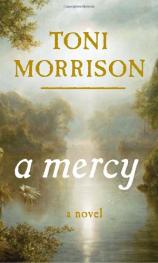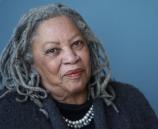A Mercy
Review
A Mercy
Like many Americans, I was first introduced to the work of Toni Morrison during my freshman year of college, when I read THE BLUEST EYE as part of a literature survey course. I moved on to several more of her books --- BELOVED, SONG OF SOLOMON, TAR BABY --- in English and women's studies courses, and have read all her other novels published since, continuing to marvel at her penetrating insights into race, sex and American history. THE BLUEST EYE, her debut, continues to be the one most often taught in college, probably because it's her shortest and most accessible. That is, until now.
Morrison's new book, A MERCY, is perhaps the perfect introduction to this Nobel Prize-winning author's work, offering readers, in fewer than 175 pages, a glimpse into her powerful literary style and keen insights into issues of race, violence, sex, history, identity and community that also demonstrates her brilliance and maturity as a writer.
The America that Morrison shows readers in A MERCY is one in its infancy, one in which "states" were hardly united, when differences of background, religion and ideology marked provincial boundaries as stark as any political border. Set in the 1680s and 1690s, it portrays a region in search of an identity, one in which the definitions of "free" and "slave" are both nebulous and shifting.
At the center of the novel is the household of Jacob Vaark. Vaark, like almost everyone in the colony, is an immigrant, a businessman who lives somewhere in the North but enters into slaveholding --- and the social grasping that seems to accompany it --- almost by accident. He obtains his first slave --- a Native American woman named Lina, whose village has been destroyed by smallpox and whose reputation has been destroyed after a rape --- to be company for his mail-order wife, Rebekka. Eventually, the two women, who develop a close friendship, are joined by another, deeply troubled slave known only as Sorrow.
Finally, the object of the "mercy" of the novel's title is Florens, bought for the Vaark household as a young girl at the entreaty of her mother. As Vaark travels on business and, later, as he becomes obsessed with building a grand home, the women form a family of sorts. After Vaark's death and Rebekka's subsequent illness, however, they discover just how fragile their bonds are, how fragmented their identities.
Vaark's household is something of a microcosm of the nascent country. Besides demonstrating the splintered identities of various American ethnic groups (and even of some individuals), the stories that make up the novel illustrate starkly and powerfully the legacy of violence, betrayal and inhumanity that is part of our nation's heritage. In particular, Morrison illustrates starkly and powerfully the ways in which slavery, in all its forms, robs people of their essential humanity and promotes the kind of "wilderness" that leads to violence, shame and despair.
Readers will come away from A MERCY feeling that they understand not only Morrison's literary techniques but also a little more about American history, marveling that out of these fragmented, isolated, brutal pieces came anything resembling unity.
Reviewed by Norah Piehl on January 7, 2011
A Mercy
- Publication Date: November 11, 2008
- Genres: Fiction
- Hardcover: 176 pages
- Publisher: Knopf
- ISBN-10: 0307264238
- ISBN-13: 9780307264237










